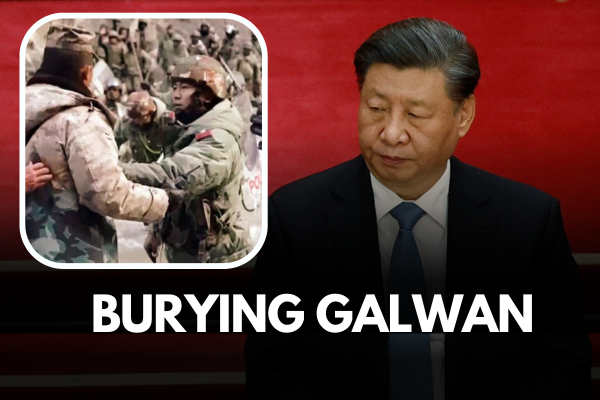The world remembers what happened on June 3, 1989 in Beijing’s Tiananmen Square. But in China, the state has gone about erasing from public memory any mention of the massacre that happened on that day.
Is China now beginning to do the same with the Galwan Valley clash of June 2020, between PLA personnel and the Indian Army? It led to the deaths of 20 Indian Army personnel including a battalion commandant. Subsequently, an unknown number of PLA personnel were killed in retaliatory attacks by India.
It is argued that comparing the Tiananmen Square massacre to Galwan is an apple vs oranges kind of thing. The former was a direct challenge to the authority of the Chinese Communist Party and there was a lot at stake. Galwan on the other hand, was small, localised and while it did upend relations with India, it was never a threat to the Chinese state.
Nevertheless, while the fifth anniversary of Galwan is being memoralised in India, the silence from the Chinese side is striking given the visible chest-thumping of the recent past. China’s state media was quiet despite high level diplomatic engagements that saw both sides turn the page on that unhappy chapter.
Curiously, there was no mention of the border disengagement in the Chinese readout of the June 12–13 meeting between Foreign Secretary Vikram Misri and Vice Minister of Foreign Affairs Sun Weidong.
Dr Jabin Jacob, a leading China studies scholar and Associate Professor at the Department of International Relations, Shiv Nadar Institution of Eminence, believes that China’s muted tone on Galwan this year is strategic, tied to its current focus on stabilising ties with India amid sensitive talks with the U.S. He believes Galwan hasn’t been erased—just downplayed for now.
“If relations with India worsen, as they likely will at some point, Galwan will be brought up again,” he said, suggesting that China sees the clash as a narrative it can revive whenever tensions resurface.
Dr Mumin Chen, Associate Professor at National Chung Hsing University in Taiwan, in an email to StratNewsGlobal, noted that since all news in China is government controlled, the absence of any mention could reflect Beijing’s current intent to project stability in its relationship with India.
He also suggested a possible shift in priorities, pointing out that Chinese authorities may be more focused on tackling pressing economic challenges—such as the impact of renewed U.S. tariffs under the Trump administration.
Manoj Kewalramani, Fellow in China Studies at The Takshashila Institution, observed that China’s silence around the Galwan anniversary may be deliberate. “An effort to normalise the relationship between the two countries is underway, so China does not want to amplify something unnecessarily,” he explained.
His remarks suggest that Beijing is consciously avoiding narratives that could disrupt the current phase of diplomatic calm with New Delhi, preferring instead to keep sensitive issues like Galwan out of the public spotlight.
Was it because China needed to focus on other issues it deemed more important? Was it because Galwan, at the end of the day, was a small irritant for China and it needed to get the India relationship back on track because of economic pressures elsewhere? China runs a surplus of around $100 billion in trade with India, which comes useful in difficult times.
How do ordinary Chinese feel? Galwan at one time featured full blown media spectacles featuring emotional tributes, state-sponsored music videos, and sweeping narratives of martyrdom.
From 2021 to 2024, China ran an intense patriotic campaign around the Galwan clash, especially mythologising Chen Xiangrong, the 18-year-old PLA soldier who died in the 2020 clash reportedly while protecting his commander.
His purported last words, “My pure love is only for China”, became a national slogan repeated across state media, school campaigns, and social media. In 2021, CCTV and Global Times featured emotional tributes, reenactments, and a patriotic song titled “18 Years Old You,” all glorifying Chen and other Galwan martyrs.
Several PLA units, bridges, and cemeteries were renamed in honour of “Galwan martyrs” like Chen Xiangrong. This was especially so in 2022, the second anniversary of Galwan, that saw a nationwide push to remember with ceremonies, documentary films and viral Weibo trends that framed the PLA personnel involved as youth icons.
But by the next year, a distinct toning down was evident although cultural events and school programmes kept the narrative alive. The new element added was China’s “Southern Tibet” propaganda campaign, where Galwan was reframed as part of the broader territorial reassertion in the Himalayas.
Another change was visible in 2024 when the Galwan clash and reportedly, the 1962 border war, was introduced into primary and middle-school textbooks. The idea clearly was to shape young minds.
This year, of course, China went completely silent—no emotional videos, no patriotic slogans, no mass campaigns, and no public ceremonies. But PLA soldier Chen Xiangrong’s former school was renamed Pingnan County Xiangrong Junior High School. It found mention in a low profile report by Global Times.
In the absence of any other explanation, it would appear that the pragmatic leadership in Beijing sees no purpose in flagging Galwan when India and China are seeking to expand trade, tourism and other links. Also, it may be that China has bigger fish to fry with the mercurial Donald Trump!
Research Associate at StratNewsGlobal, A keen observer of #China and Foreign Affairs. Writer, Weibo Trends, Analyst.
Twitter: @resham_sng





